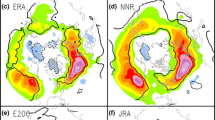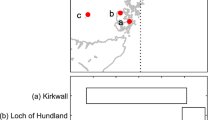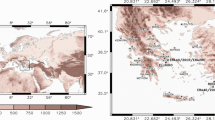An objective methodology is applied to ERA-40 (European Centre for Medium-Range Weather Forecasts 40-year Reanalysis) and NCEP/NCAR (National Centers for Environmental Prediction/National Center for Atmospheric Research) reanalyses, to build two storm-track databases for the Euro-Atlantic sector (85°W–70°E; 20°N–75°N), spanning the period December 1958–March 2000. The technique uses the full temporal (6-hourly) and spatial resolutions (1.125° and 2.5° regular grids, for ERA-40 and NCEP/NCAR, respectively) available. It is shown that the strong discrepancies in the number of storms in each dataset (higher for ERA-40) result from differences in the resolution of the fields subject to the storm detecting/tracking algorithm, and also from the characteristics of the integration models and assimilation schemes used for each reanalysis. An intercomparison of ERA-40 and NCEP/NCAR storm-tracks is performed for spatial distribution, and main characteristics, of the overall cyclone population and of a class of severe storms—explosive cyclones. Despite the discrepancies in storm numbers, both reanalyses agree on the main cyclone activity areas (formation, minimum central pressure, and lysis). The most pronounced differences occur where subsynoptic systems are frequent, as these are better resolved by ERA-40 data. The interannual variability of cyclone counts, analysed per intensity classes and for different regions of the domain, reveals reasonable agreement between the two datasets on the sign of trends (generally positive in northern latitudes, and negative in the Azores-Mediterranean band), but discrepancies regarding their strength in the most southern areas, where the mismatches between ERA-40 and NCEP/NCAR detected lows are greatest.









Similar content being viewed by others
References
Agee EM (1991) Trends in cyclone and anticyclone frequency and comparison with periods of warming and cooling over the Northern Hemisphere. J Clim 4:263–267
Alpert P, Neeman BU (1992) Cold small-scale cyclones over the eastern Mediterranean. Tellus 44A:173–179
Alpert P, Neeman BU, Shay-El Y (1990) Climatological analysis of Mediterranean cyclones using ECMWF data. Tellus 42A:65–77
Alpert P, Ben-Gai T, Baharad A, Benjamini Y, Yekutieli D, Colacino M, Diodato L, Ramis C, Homar V, Romero R, Michaelides S, Manes A (2002) The paradoxal increase of Mediterranean extreme daily rainfall in spite of decrease in total values. Geophys Res Lett 29:DOI 10.1029/2001GL013554
Andrae U, Sokka N, Onogi K (2004) The radiosonde temperature bias correction used in ERA-40 ERA-40 Project Report Series No. 15, Reading, MA, pp 1–34
Blender R, Fraedrich K, Lunkeit F (1997) Identification of cyclone track regimes in North Atlantic. Q J R Meteorol Soc 123:727–741
Blender R, Schubert M (2000) Cyclone tracking in different spatial and temporal resolutions. Mon Weather Rev 128:377–384
Brunetti M, Colacino M, Maugeri M, Nanni T (2001a) Trends in the daily intensity of precipitation in Italy from 1951 to 1996. Int J Climatol 21:299–316
Brunetti M, Maugeri M, Nanni T (2001b) Changes in total precipitation, rainy days and extreme events in Northeastern Italy. Int J Climatol 21:861–871
Dickson RR, Osborn TJ, Hurrell JW, Meincke J, Blindheim J, Adlandsvik B, Vinje T, Alekseev G, Masloske W (2000) The Artic Ocean response to the North Atlantic Oscillation. J Clim 13:2671–2696
Førland EJ, Alexandersson H, Drebs A, Hanssen-Bauer I, Vedin H, Tveito OE (1998) Trends in maximum 1-day precipitation in the Nordic Region. DNMI Report 14/98 klima, Norwegian Meteorological Institute, Oslo, pp 1–55
Gulev SK, Zolina O, Grigoriev S (2001) Extratropical cyclone variability in the Northern Hemisphere winter from the NCEP/NCAR reanalysis data. Clim Dyn 17:795–809
Hanson CE, Palutikof JP, Davies TD (2004) Objective cyclone climatologies of the North Atlantic—a comparison between the ECMWF and NCEP reanalyses. Clim Dyn 22:757–769; DOI 10.1007/s00382-004-0415-z
Hayden BP (1981) Secular variation in Atlantic Coast extratropical cyclones. Mon Weather Rev 109:159–167
Hirsch RM, Slack JR (1984) A non-parametric trend test for seasonal data with serial dependence. W Resour Res 20(6):727–732
Hodges KI, Hoskins BJ, Boyle J, Thorncroft C (2003) A comparison of recent reanalysis using objective feature tracking: storm tracks and easterly waves. Mon Weather Rev 131:2012–2037
Hulme M, Barrow EM, Arnell NW, Harrison PA, Johns TC, Downing TE (1999) Relative impacts of human-induced climate change and natural climate variability. Nature 397:688–691
Hurrel JW (1995) Decadal trends in the North Atlantic Oscillation: regional temperatures and precipitation. Science 269:676–679
Kalnay E, Kanamitsu M, Kistler R, Collins W, Deaven D, Gandin L, Iridell M, Saha S, White G, Woolen J, Zhu Y, Chelliah M, Ebisuzaki W, Higgins W, Janowiak J, Mo KC, Ropolewski C, Wang J, Leetmaa A, Reynolds R, Jenne R, Joseph D (1996) The NCEP/NCAR 40-year reanalysis project. Bull Am Meteorol Soc 77:437–471
Kistler R, Collins W, Saha S, White G, Woollen J, Kalnay E, Chelliah M, Ebisuzaki W, Kanamitsu M, Kousky V, van den Dool H, Jenne R, Fiorino M (2001) The NCEP-NCAR 50-year Reanalysis: monthly CD_ROM and documentation. Bull Am Meteor Soc 82:247–267; DOI 10.1175/1520-0477(2001)082
Klein WH (1957) Principal tracks and mean frequencies of cyclones and anticyclones in the Northern Hemisphere. Research Paper 40, U.S. Weather Bureau, pp 1–60
Lau NC (1988) Variability of the observed midlatitude storm tracks in relation to low-frequency changes in the circulation pattern. J Atmos Sci 45:2718–2743
Lim E-P, Simmonds I (2002) Explosive cyclone development in the southern hemisphere and a comparison with northern hemisphere. Mon Weather Rev 130:2188–2209
Marshall J, Kshnir Y, Battisti D, Chang P, Czaja A, Dickson R, Hurrell J, McCartney M, Sravan R, Visbeck M (2001) North Atlantic climate variability: phenomena, impacts and mechanisms. Int J Climatol 21:1863–1898
Osborn TJ, Briffa KR, Tett SFB, Jones PD, Trigo RM (1999) Evaluation of the North Atlantic Oscillation as simulated by a coupled climate model. Clim Dyn 15:685–702
Osborn TJ, Hulme M, Jones PD, Basnett TA (2000) Observed trends in the daily intensity of United Kingdom precipitation. Int J Climatol 20:347–364
Petterssen S (1956) Weather analysis and forecasting, vol I: Motion and motion systems. McGraw-Hill, New York, pp 1–428
Rogers JC (1990) Patterns of low-frequency monthly sea level pressure variability (1899–1986) and associated wave cyclone frequencies. J Clim 3:1303–1310
Rogers JC (1997) North Atlantic storm track variability and its association to the north Atlantic oscillation and climate variability of northern Europe. J Clim 10:1635–1647
Sanders F (1986) Explosive cyclogenesis in the West-Central North Atlantic Ocean, 1981–84 Part I: composite and mean behavior. Mon Weather Rev 114:1781–1794
Sanders F, Gyakum JR (1980) Synoptic-dynamic climatology of the “bomb”. Mon Weather Rev 108:1589–1606
Schmith T, Kaas E, Li T-S (1998) Northeast Atlantic winter storminess 1875–1995 reanaysed. Clim Dyn 14:529–536
Serreze MC, Carse F, Barry RG, Rogers JC (1997) Icelandic low cyclone activity: climatological features, linkages with the NAO, and relationships with recent changes in the northern hemisphere circulation. J Clim 10:453–464
Sickmöller M, Blender R, Fraedrich K (2000) Observed winter cyclone tracks in the northern hemisphere in re-analysed ECMWF data. Q J R Meteorol Soc 126:591–620
Simmons AJ (2001) Development of the ERA-40 data assimilation system. In: Proceedings of the workshop on reanalysis, ECMWF, Reading, UK, pp 11–30
Sinclair MR (1995) A climatology of cyclogenesis for the Southern Hemisphere. Mon Weather Rev 123:1601–1619
Sinclair MR (1997) Objective identification of cyclones and their circulation, intensity and climatology. Weather Forecast 12:595–612
Tayanç M, Karaca M, Dalfes HN (1998) March 1987 cyclone (blizzard) over the Eastern Mediterranean and Balkan region associated with blocking. Mon Weather Rev 126:3036–3047
Trigo IF, Davies TD, Bigg GR (1999) Objective climatology of cyclones in the Mediterranean Region. J Clim 12:1685–1696
Trigo IF, Davies TD, Bigg GR (2000) Decline in Mediterranean rainfall caused by weakening of Mediterranean cyclones. Geophys Res Lett 27:2913–2916
Trigo IF, Bigg GR, Davies TD (2002) Climatology of cyclogenesis mechanisms in the Mediterranean. Mon Weather Rev 130:549–569
Trigo RM, Pozo-Vasquez D, Osborn TJ, Castro-Diez Y, Gámis-Fortis S, Esteban-Parra MJ (2004) North Atlantic Oscillation influence on precipitation, river flow and water resources in the Iberian Peninsula. Int J Climatol 24:925–944
Ulbrich U, Christoph M (1999) A shift of the NAO and increasing storm track activity over Europe due to anthropogenic greenhouse gas forcing. Clim Dyn 15:551–559
van Loon H, Williams J (1976) Connection between trends of mean temperature and circulation at the surface 1 Winter. Mon Weather Rev 104:365–380
Xoplaki E, González-Rouco JF, Luterbacher J, Wanner H (2004) Wet season Mediterranean precipitation variability: influence of large-scale dynamics and trends. Clim Dyn 23:63–78; DOI 10.1007/s00382-004-0422-0
Zolina O, Gulev SK (2002) Improving accuracy of mapping cyclone numbers and frequencies. Mon Weather Rev 129:748–759
Acknowledgement
The NCEP/NCAR Reanalysis data was kindly provided by the Climatic Research Unit. The author is grateful to Ricardo Trigo for his helpful comments. This work was supported by the Portuguese Science Foundation (FCT) through project VAST (Variability of Atlantic Storms and Their impact on land climate) POCTI/CTA/46573/2002.
Author information
Authors and Affiliations
Corresponding author
Additional information
Submitted to Climate Dynamics in December 2004
Rights and permissions
About this article
Cite this article
Trigo, I.F. Climatology and interannual variability of storm-tracks in the Euro-Atlantic sector: a comparison between ERA-40 and NCEP/NCAR reanalyses. Clim Dyn 26, 127–143 (2006). https://doi.org/10.1007/s00382-005-0065-9
Received:
Accepted:
Published:
Issue Date:
DOI: https://doi.org/10.1007/s00382-005-0065-9




